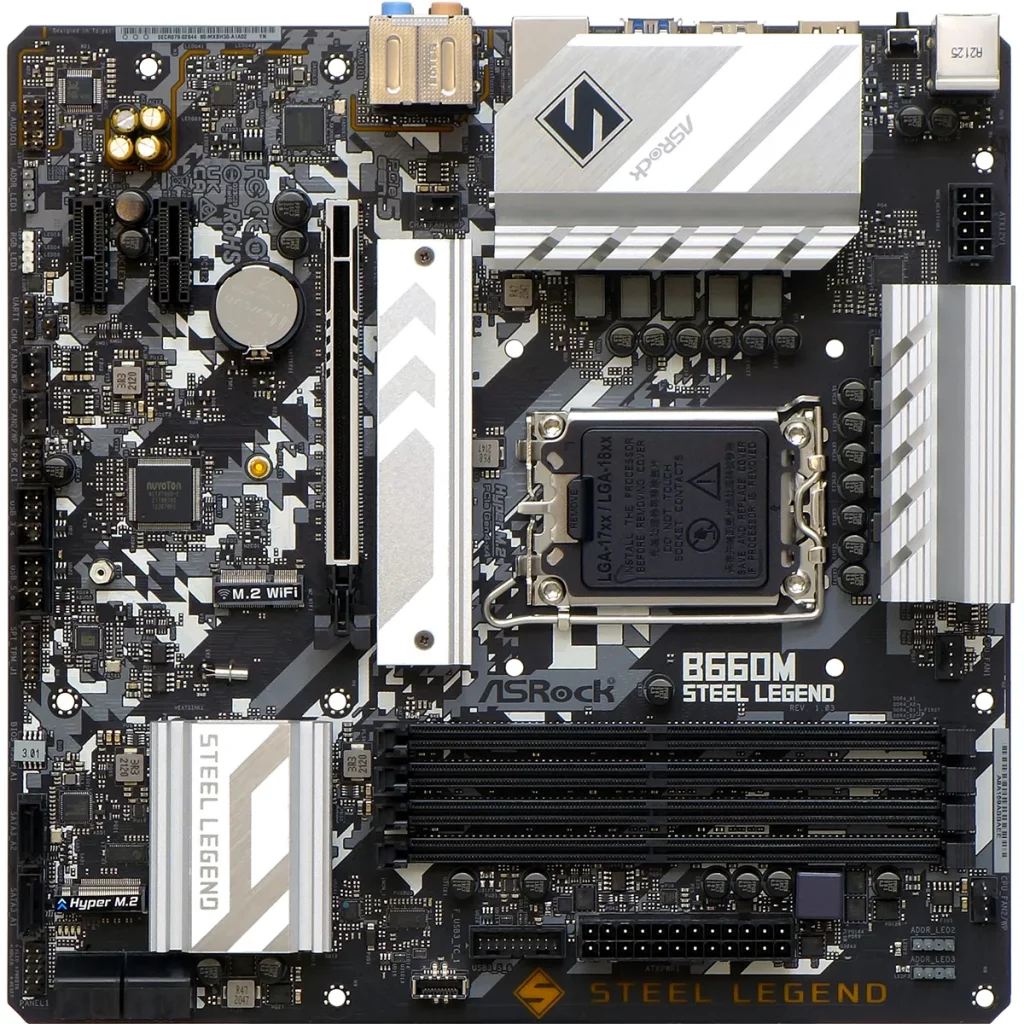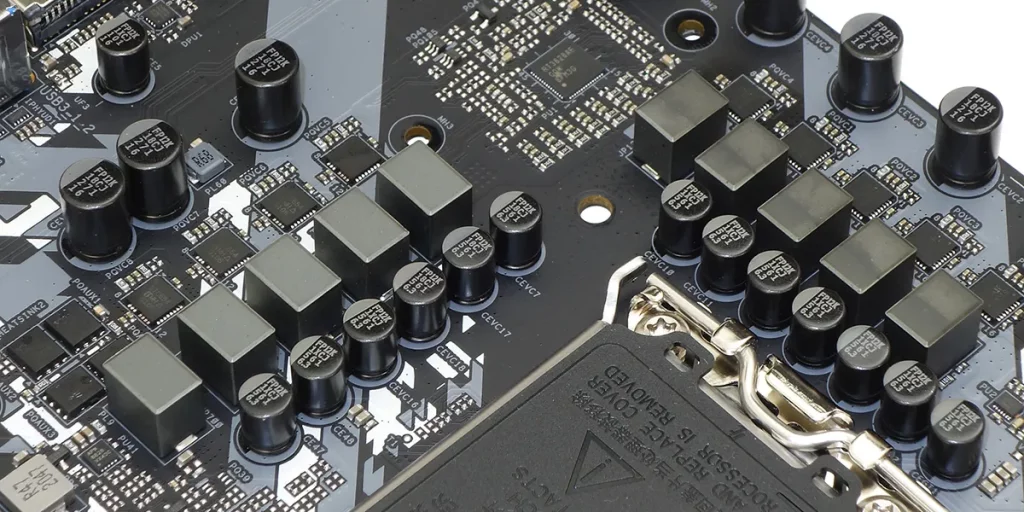Low-Cost Alder Lake? B660M Steel Legend Motherboard Review
Contents
Intel’s LGA 1700 launch brought us many advancements, from faster new core technology to PCIe 5.0 graphics and doubled bandwidth for the chipset interconnects, but some of the costlier features such as DDR5 were simply over the top for budget builders. Budget boards were part of the eventual plan, but even the first one we tested was far more expensive than its predecessors. Now that we have something that most buyers can probably afford, the only question is whether it’s good enough to win their approval.

We’re talking about the B660M Steel Legend, a Micro ATX design which has so few ports that one might wonder what else it’s missing. Some important pros are less obvious than its visible cons, such that its missing USB Type-C port on the I/O panel is counterbalanced by its USB 3.2 Gen2x2 (20Gb/s) connection to the front panel. For comparison, the costlier B660M-Plus WiFi D4 stuck its front-panel Gen2 connector with a Gen1 (5Gb/s) interface. Given that both of these micro ATX B660 models have only a single 20Gb/s interface, we think that many users would find the front panel as the most attractive place to put it.

We see a few additional sacrifices for those hoping to save around $50 on this cheaper model, such as the loss of Wi-Fi and several 10Gb/s Type A ports, but the B660M Steel Legend gives its buyers a little extra convenience with a BIOS Flashback button. It also has the same 2.5GbE controller as its higher-priced Asus rival.

ASRock’s B660M Steel Legend doesn’t have its competitor’s four-lane x16-length slot, but this cheaper board’s two PCIe x1 slots are still open-ended to support longer cards. It also has the same number of M.2 NVMe slots at two, one above the top expansion slot and the other below the chipset heat sink. In a nod to budget builders, ASRock even adds SATA compatibility to the one closer to the board’s bottom edge, and expands SATA cable header count to six.

The B660m Steel Legend even has the same SiC654 MOSFETs as its competitors, though the Asus model has more of these. ASRock’s design uses a Richtek RT3628AE controller, and it’s easier to see how its 9+1 phase design is split since the non-core phase uses different FETs.

A legacy ASM1061 SATA controller feeds the two ports closes to the bottom, while the PCIe switch next to it determines whether the chipset’s fourth SATA port goes to a cable header or an M.2 device…by detecting whether the M.2 device is NVMe or SATA. Using an SATA M.2 drive means losing an SATA cable interface.

Fed by Realtek’s low-cost ALC897 audio codec, the HD_Audio header resides next to the B660M Steel Legend’s first (of three) addressable LED (ARGB) headers, its sole legacy RGB header, a three-pin UART and two pin CLR_CMOS header, two (of five) PWM fan headers, a legacy PC Speaker/Chassis Intrusion combo header, and a pair of legacy USB 2.0 front-panel headers. The big IC at the top of this photo is nothing other than a legacy ASM1074 USB 3.0 hub…which has been re-specified as USB 3.2 Gen1, and the UART header isn’t even documented within the B660M Steel Legend’s user manual.

Up top are the other two ARGB and two more fan headers.

| ASRock B660M Steel Legend | |||
| Socket | LGA 1700 | Form Factor | Micro ATX |
| Chipset | Intel B660 PCH | Voltage Regulator | 10 Phases |
| Rear I/O | |||
| Video Ports | Displayport 1.4, HDMI 2.1 (4k/60Hz Max) | Audio Jacks | (5) Analog, (1) Digital Out |
| Rear USB | (4) 5Gb/s Type A, (2) USB 2.0 | Legacy Ports/Jacks | ✗ |
| Network Jacks | 2.5GbE, (2) Wi-Fi Antenna | I/O Panel Extras | USB BIOS Flashback Button |
| Internal Interface | |||
| PCIe x16 | (1) v5.0 (full x16) | SATA Ports | (6) 6Gb/s (*1 shared with SATA M.2) |
| PCIe x8 | ✗ | USB Headers | (1) v3.x Gen2x2 (20Gb/s), (1) v3.x Gen1, (2) v2.0 |
| PCIe x4 | ✗ | Fan Headers | (5) 4-Pin |
| PCIe x1 | (2) v3.0 | Legacy Interfaces | UART (3-pin), System (Beep-code) Speaker, Chassis Intrusion |
| CrossFire/SLI | ✗ / ✗ | Other Interfaces | FP-Audio, TPM, (1) RGB LED, (3) ARGB LED |
| DIMM slots | (4) DDR4 | Diagnostics Panel | ✗ |
| M.2 slots | (1) PCIe 4.0 x4, (1) PCIe 4.0 x4 / SATA*, (1) Key-E / CNVi | Internal Button/Switch | ✗ / ✗ |
| Controllers | |||
| SATA Controllers | Integrated (0/1/5/10), ASM1061 PCIe | USB Controllers | ASM1074 Hub |
| Ethernet Controllers | RTL8125BG 2.5Gb/s PCIe | HD Audio Codec | ALC897 |
| Wi-Fi / Bluetooth | ✗ | DDL/DTS Connect | ✗ |
Get it at Amazon

(click for availability)
Though it’s displayed prominently at the center of the board, we make little mention of the B660M Steel Legend’s “M.2 WiFi” slot. That’s because using it requires builders to procure a module and the correct length antenna extension cables to reach the I/O panel, knock out the antenna holes of the I/O panel shield, and hang their antennas from that flimsy piece of sheet. Because of that last detail, all of that expense and effort would provide an inferior result compared to factory-installed solutions.

In addition to its snap-in I/O shield, the B660M Steel Legend includes a Steel Legend logo keyboard cap, software and hardware manuals, a driver and application DVD, two SATA cables, two hook-and-loop cable straps, and a Steel Legend postcard. If you don’t know what a postcard is, think Instagram for old-timers.
